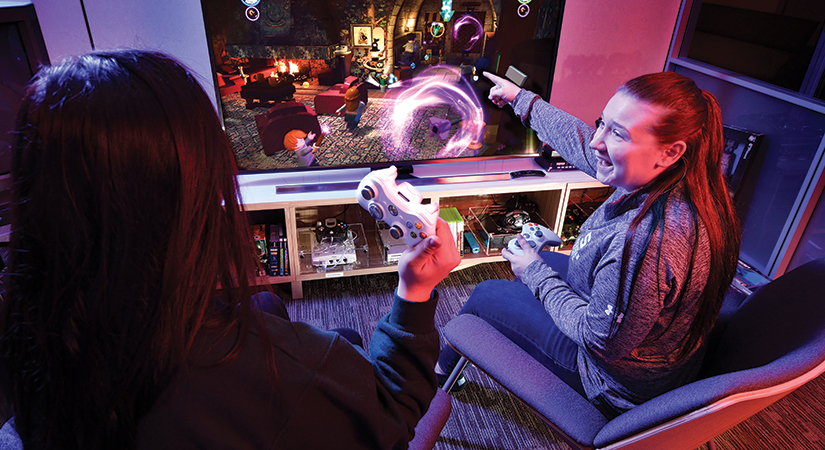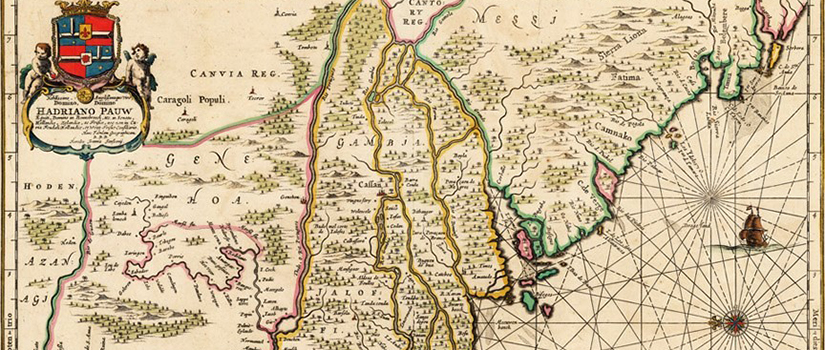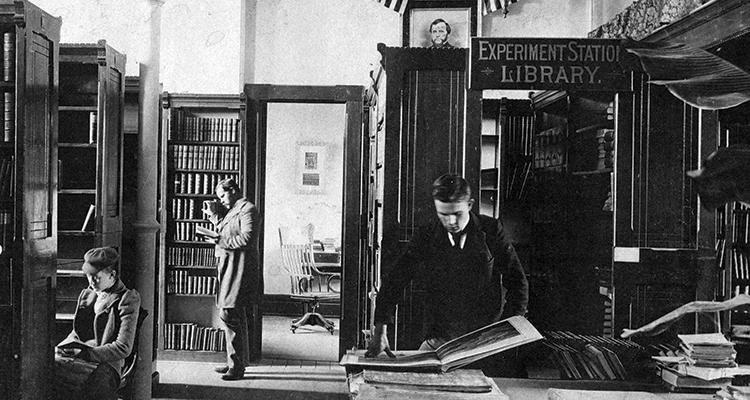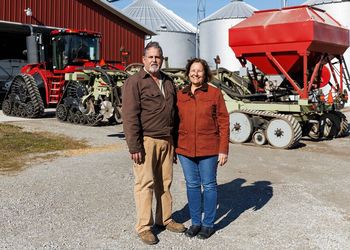Check it Out! MSU Libraries is MSU's top Reference Point

Check it Out! MSU Libraries is MSU's top Reference Point
MSU Libraries hold millions of ways to explore the depth of human knowledge and history, serving as vital gathering place for information and those who seek it. Take this fast-paced tour of to learn about revolutionary ways of teaching, learning and over-the-top resources.
October 1, 2018While the means through which we acquire and share knowledge are accelerating faster than you can say fiber-optic cable, the importance of information—new and historic—remains an essential part of human life on civic, social, and economic levels, and beyond.
Behold the library, whose noble aim is to remove barriers and make that information, in all its forms, accessible for all. Like the languages it encompasses, a library is a living thing, constantly evolving and adapting to the needs of its time and its patrons.
This year, MSU is welcoming its new university librarian, Joseph Salem Jr., and expressing gratitude to its recently retired veteran director, Cliff Haka, whose vision elevated the library from a respectable collection of holdings to an energized, popular destination that draws students, faculty, and scholars eager to learn, create, and socialize.
There’s nothing musty about it. It’s the only place on campus where you can experience a 360-degree view inside a working artery, marvel at extremely rare books, grab a latte and a snack to sustain yourself while reading, pet a therapy dog and feast on free donuts during finals week, dive into one of the world’s greatest comic book collections, learn the fine points of turf grass, borrow DVDs and CDs from the expansive Rovi Media Collection, or study an amazing group of maps.
But wait, there’s more. Join us on an armchair tour.
1: Digital Scholarship Lab

Welcome to the future. You’ll begin your journey in a 10,000-square-foot space worthy of Star Trek’s “holodeck.” It’s formally known as the Digital Scholarship Lab.
The crew of the show’s starship USS Enterprise used its holodeck (Holographic Environment Simulator) for recreation. What was science fiction in 1974 becomes reality as a tool for education and research at MSU.
The lab’s focal point is the 360-degree immersive visualization room, the first of its kind at a U.S. university. Within its confines, teams can collaborate in research and training, classes can “visit” distant places, and designers can bring their sketches to life.
On top of that, visitors can experience virtual reality. Open to all faculty and students, the lab features a virtual reality room with VR headsets, a dedicated room for digitization projects, offices, instructional space, meeting rooms, and work stations outfitted with high-speed computers and powerful software easily outdoing what Capt. Kirk had at his command.
Opened in February, the Digital Scholarship Lab is the result of a partnership between the College of Arts and Letters and the MSU Libraries. “This state-of-the-art facility will elevate our widely recognized strengths in the digital arts and humanities,” Christopher P. Long, dean of the College of Arts and Letters, predicts. “It is bound to be a destination for the best students and faculty from around the world.”
2: Cookery and Food
To paraphrase French lawyer and author Jean Anthelme Brillat-Savarin (1826): We are what we eat. This holds true not only in the senses of health and physique. MSU’s Cookery and Food Collection, one of the largest in the nation, tells us what the world’s societies ate, and, in so doing, tells us a lot about cultural identity over and through time.
This collection contains more than 25,000 cookbooks dating from the 16th century to the present. Manuscript “receipts” reveal the handing down of dishes from one cook to another. Rarities include Amelia Simmons’ American Cookery (1798), the first cookbook published in America. The collection is rich in holdings of African and African-American cookery, charting the influence of West African foodways in the Americas. Community pride is chronicled by the Michigan Cookbook Project, an ongoing program to collect materials published in the state, including cookbooks created by communities, organizations, churches, and individuals.
Industrial food production and kitchen technology continue to change the ways humans grow and purchase, cook and keep, and consume food. The Alan and Shirley Brocker Sliker Culinary Collection features thousands of publications by U.S. companies intent on introducing new foods and new ways of cooking into the American home. (There’s always room for JELL-O!)

3: Faculty Book Collection
Our librarians have long collected multimedia created by faculty and academic staff. The work spans generations. One of the earliest pieces is Shadows from the Walls of Death, by Chemistry Professor Robert C. Kedzie (1823–1902). It’s one of 100 albums he filled with 19th-century wallpapers embedded with arsenic. The toxin yielded fashionably vivid colors, especially greens.
Kedzie, a former physician and a member of Michigan’s first State Board of Health, understood the element’s danger to health and life. He distributed his albums to all state libraries, warning people of the hazardous material. Only four books remain.
Now, books, multimedia creations, musical scores, and recordings by faculty are collected annually. The ever-growing body of work charts MSU’s contributions to the world’s knowledge. Find the latest additions in the Stanley C. and Selma D. Hollander Faculty Book Collection Alcove.

4: Selma D. and Stanley C. Hollander MakeCentral: Makerspace
Some folks read directions. Others pick up one piece and start assembling. And then there are those who want to take those pieces, rewrite the directions, and make something altogether new. It’s all good.
In the Main Library’s MakeCentral, students and faculty find a supportive environment in which to discover, experiment, collaborate, design, and invent. These communal “makerspaces” are part of what some experts are calling the New Industrial Revolution, in which do-it-yourselfers are using old and new technologies as ways of learning and sharing skills and knowledge (i.e., directions are important).
MakeCentral, like other makerspaces in public and academic libraries across the nation, provides access to tools. Want to publish your own book? MakeCentral staff can help you design and print it. Or you can dabble in such new technologies as 3D printing or borrow a starter kit to learn how programming and a computer’s “innards” work together.
MakeCentral is not just a space. It’s a new mindset.

A trio of 3D printers are available for users to crank out plastic prototypes, models, toys and other original and existing designs.
5: Library Makes Finals Week a Little Sweeter with Dogs, Doughnuts
Finals week isn’t what it used to be. Not long ago, lack of study space, uncomfortable temperatures, and the occasional stress-induced outburst from students inspired Holly Flynn, outreach librarian, to get creative.
In May 2012, she and a colleague organized a “stress-free zone” in the Main Library. They filled the room with snacks, games, hula hoops, and music to provide pleasant breaks from the strain of finals week. Even though they posted flyers throughout the building, a grand total of two students showed up.
This motivated Flynn and her co-workers to contact other universities to see if they had better ways to support students during the finals crunch. With help from librarians at “that school down the road,” Flynn and her colleagues slowly but surely built a legendary finals week event that has become a staple for MSU students.
“With our past experiences, good and bad, we knew that students liked animals, free food, and higher-quality entertainment than hula hoops,” Flynn said with a laugh.
She also called on her contacts in the Counseling Center, Career Services, and Admissions offices, who owned therapy dogs.
“They were just bursting to share their comforting pets with our students,” she added.

With the help of more strategic marketing, social media, and grassroots outreach, hundreds of students came in to relax with some friendly, furry friends and relieve some exam-week stress.
In December 2014, librarians loaded up book carts with 83 dozen doughnuts, 40 gallons of coffee, and healthy snacks. They wheeled the refreshments around the library that evening.
Surprised students devoured more than 1,000 doughnuts in under an hour. Hence “The Night of A Thousand Donuts,” a finals week tradition, was born.
Since then, a week-long schedule of events provides comfort and entertainment throughout the fi nals rush.
Student employees, outside departments, and Greek life help make it possible and successful. Not to mention valuable donations from MSU Federal Credit Union—alleviating concern that a book budget would be spent on doughnuts. -Allison Bertram, '18

6: Turfgrass Information Center
Our football fi eld’s natural turfgrass (installed in 2002) is the result of over three centuries of research and experiment by scientists, amateurs, and companies. The Turfgrass Information Center’s collection reflects this long history of investigation into the cultivation and care of turf on golf courses and sports fields, parks, lawns, and sod farms, as well as the social and cultural changes these landscapes reflect and foster.
The Center was established in 1984 with the help of the U.S. Golf Association (USGA). MSU turfgrass scientist James B Beard and Libraries Director Richard Chapin had been building the collection since the early 1960s. With the financial support of the USGA, an online database of turfgrass literature was established, providing historical and scientifi c information to a wide variety of users. The Turfgrass Information Center’s collection is the world’s largest, with more than 250,000 records.

7: Comic Art in the Russel B. Nye Popular Culture Collection
“From ‘aaugh!’ to ‘zoinks!’” would be a fitting title of a list of all the comic books, comic strips, fotonovelas, graphic novels, and related materials in the Comic Art Collection. But holy numbers, Batman!
The collection of over 300,000 items is the largest of its kind. Its Green Lantern-like strengths are in American, European, and Latin American holdings, but its collecting scope is international. The collection was established in 1970 by Russel B. Nye (1913–1993), Department of English, a pioneer in the scholarly study of popular culture and the university’s only Pulitzer Prize winner. The Russel B. Nye Popular Culture Collection is also rich in magazines beyond comics that parents often forbade children to read: think confession, crime, and scandal magazines, romance and western dime novels, and science fiction. What’s more, it also houses “appropriate” literature, in the form of Sunday-school books, textbooks, and children’s literature, dating from the 19th century.

Geoff Johns, ’95, founder of Mad Ghost Productions, is currently writing the anticipated feature Green Lantern Corps, in addition to gearing up for the Warner Brothers Aquaman movie release in December.
8: Rovi Media Collection
Pac-Man to Pokémon. Hello, Dolly! to Hello Kitty. Louis Armstrong to Led Zeppelin. The library is home to the Rovi Media Collection, the largest of its kind in an American library.
Donated in 2015 by Rovi Corp., this collection numbers over 850,000 items, including CDs, DVD and Blu-ray movies, and video games produced since the early 1990s. The gaming collection—numbering over 17,000 items—represents entertainment systems from Atari to Zodiac and is the largest known library collection of its kind worldwide. Whether enthusiasts or researchers, patrons may borrow games to play in the library’s comfy Video Game Labs.
In addition, the Rovi Media Collection is a one-of-a-kind resource for game designers and developers, musicians, film historians, and cultural studies scholars. It’s so new that professional cataloging and processing standards don’t easily apply. MSU’s librarians are creating new pathways in the 21st century’s Information Age.

The Rovi Collection’s video games allow students to relive their childhood pastimes.
9: Map Library
Every MSU freshman has uttered this phrase: “Excuse me, could you tell me where …?” Campus maps have saved generations of Spartans on their first days of classes and represent the many changes to the campus’ landscape.
MSU’s Map Library holds more than 250,000 sheet maps (dating back to the 17th century), 14,000 folded geologic maps, and 4,000 atlases, gazetteers, and other maps that show how geographical knowledge has been and continues to be drawn, debated, and distributed. The Map Library collects in all areas, but is especially strong in North and Latin America, Africa, and Asia.

10: César E. Chávez Collection/Colección César E. Chávez
"The end of all education should surely be service to others,” César E. Chávez (1927–1993) said. A Mexican-American farm worker, his formal education was cut short. But he never stopped learning and pushing for better working conditions. In 1962, he founded the National Farm Workers Association—now the United Farm Workers (UFW).
His office at the labor union’s headquarters housed hundreds of books, ranging from philosophy to the history of unions. Our César E. Chávez Collection reflects the leader’s cultural roots and commitment to human rights, labor activism, education, the arts, and a belief in non-violence.
You’ll find written works, voice and video titles, educational comic books, and the Illegal Superheroes Wanted Posters, part of a series that includes the Superman poster shown.
Chávez toured Michigan in the 1970s and 1980s, finding strong support for UFW boycotts, strikes, and programs. In 2017, the Lansing City Council renamed part of Grand River Avenue in Old Town as César E. Chávez Avenue.

Posters like this challenge viewers to rethink perceptions of the illegal alliens label.
11: G. Robert Vincent Voice Library
In 1912, a fearless 14-year-old borrowed a cylinder recording device from a pal to capture a message by a prominent American citizen. That citizen was Bull Moose Party presidential candidate Theodore Roosevelt. The pal was inventor Thomas Edison’s son Charles. And the tenacious teen was George Robert Vincent (1898–1985). It sparked Vincent’s lifelong passion: immortalizing the words of figures, from the famous to the otherwise unfamiliar.
Fifty years later, MSU accepted Vincent’s gift of 8,000 sound recordings, leading to the establishment of the G. Robert Vincent Voice Library. “Print stands for the word,” Vincent said in 1965, “but it never is, it never can be the word itself. Only the spoken voice can bring the word fully to life.” (Anyone who has ever misinterpreted an email’s intent truly understands this.) Today the collection, one of the largest of its kind, numbers over 250,000 items, including the voices of more than 500,000 individuals dating back to 1888.
As Vincent did, the librarians and technicians of the voice library transfer sound recordings into new formats, increasing patrons’ access. You too may listen to Vincent’s first recording of Theodore Roosevelt and the voices of an astounding number of figures from times gone by. Visit go.msu.edu/vincent-voice.

Thomas Edison was on to something major when he invented methods to capture and play voices.
12: More Special Collections
On the first floor of the Main Library is a spacious and proverbial Wunderkammer, a “wonder chamber” or “cabinet of curiosities.” In the 16th century, Europeans began creating such private collections of natural and human-made wonders, putting order to and making available the world’s knowledge.
Libraries today continue this important work.
Perhaps the closest comparison to Europeans’ early compendiums is known as the Libraries’ Special Collections. Established in 1962, it holds unique and rare works, extending their lives for future generations.
Many of the items you’ve read about in the preceding pages are housed within Special Collections. But there are many other groupings under that umbrella. Here are but a few of the additional collections:
AMERICAN RADICALISM COLLECTION
The American Radicalism Collection, established in the 1950s with materials from the Communist Party of the USA, has expanded to cover radical movements and thought on both the Right and the Left. With more than 17,000 books, pamphlets, zines, posters, and more, the collection is particularly strong in materials about 20th-century movements and groups, from the Ku Klux Klan of the 1920s and 1930s to the Black Panthers, and from the Trotskyite Socialist Workers Party to the 1960s-era anti-war movement.
AFRICANA COLLECTION
The Africana Collection is one of the largest in the United States—a collection that is not just comprehensive but peerless. It originated in the 1960s to help sustain MSU faculty working on and with those living on the African continent.
MSU partnered with the University of Nigeria Nsukka. Since then, the compendium has grown in both number and breadth of subjects.
Books, journals, maps, films, archives, and ephemera help sustain research, teaching, and outreach by the university’s large and active African Studies community.
It is especially robust in materials from the post-colonial period and builds on the strengths of popular culture and radicalism. Cookbooks, broadsheet newspapers, protest posters, and political and campaign items from numerous African nations are preserved in perpetuity.
Some of the intellectual property—such as papers by retired African studies professors and numerous activists—cannot be found anywhere else.
Did you know this year marks the 40th anniversary of MSU’s divestment from apartheid-related companies in South Africa? MSU was the first American university to do so.
LBGTQ+ COLLECTION
The LBGTQ+ Collection was one of the fi rst of its kind in the world when it was established in the late 1970s. Today, its holdings include popular literature, periodicals, rare books, and archival collections—giving voice to LGBTQ+ individuals and groups. Magazines, entertainment guides, newspapers, newsletters, and pride guides from across the U.S. and around the globe cover a rainbow of issues, from civil rights and social movements to persecution and acceptance.
VETERINARY MEDICINE HISTORICAL COLLECTION
It’s just horse sense that a veterinary collection was established soon after the Michigan Agricultural College was founded. A century later, J. Fred Smithcors, professor of anatomy in the College of Veterinary Medicine, turned his attention to the collection. He found some 200 books published before 1950. In 1957, Smithcors acquired the Beaudette Collection of more than 250 rare books, manuscripts, and incunabula, which are pamphlets or broadside newspapers printed in Europe before 1501.
The collection has grown to more than 1,500 items, making it one of the nation’s fi nest. Included in the collection is Elemens d’Hippiatrique by Claude Bourgelat, the founder of the world’s fi rst school of veterinary medicine in Lyons, France.
MSU also has the only known copy of the first edition (1547) of Libro De Albeyteria, a veterinary manual by Francisco de la Reyna, who theorized the circulation of blood 80 years before William Harvey’s description of the circulatory system.
13: Antiques & Art Books
Sure, some of our oldest books may look like they’re on loan from Hogwarts School; however they’re crucial to understanding how we’ve arrived at where we are today. If civilization is built on accumulating knowledge and sharing cultural experiences, then antique books are glimpses into how things played over centuries. And in a new first-floor seminar room, visitors may engage with such gems as a wealthy Parisian family’s 1480s-era hand-lettered, colorfully painted Book of Hours, evidence of religious piety. Or patrons can leaf through Walt Whitman’s 1855 Leaves of Grass. In addition, the library houses contemporary artists’ creations that challenge the very idea of what a book is and how it looks. Professor Liam Brockey’s History of the Book class has been introducing students to the vast holdings every fall for the last three years. Brockey and his students use Special Collections as a kind of learning laboratory, tracing the development of culture—Western and Eastern alike—though published materials. The library’s conservation unit helps ensure the treasured holdings may be safely handled and repaired when needed. This vital work safeguards the cherished collection so Spartans of the future—decades, even centuries down the line—will have the same opportunities as we do today.

Botanical names of various plants eaten by people during famines are written on paper strips in Global Salad: Famine Foods by Catherine Casey. The vegetation is low in nutritional value but when ingested gives a sensation of being full—despite the fact that the plants can cause cramps or diarrhea.
Library History Timeline
1855
MSU Libraries starts with a 200-volume collection with the founding of the Agricultural College of the State of Michigan. The library was housed in a single reading room on the third floor of College Hall, MSU’s first classroom building, which has since been demolished.
1881
The library moves to Linton Hall, MSU’s oldest standing academic building.
1916
The library collection grows to more than 30,000 volumes, and additional space was created by excavating underneath the building.
1925
After six years of construction and $300,000 of government-funded money, a new library building opens its doors. Today, that building houses the MSU Museum. The library occupied the building until 1955.
1933
MSU Library ranks seventh in the nation for its extensive collections in botany and horticulture.
1955
In less than 25 years, the library outgrows its building. A new building is constructed and student in long lines move boxes of books to the new library, which stands today.
1963
The collection reaches 1 million volumes and would exceed 2 million volumes 10 years later.
1989
The library catalogue goes online, making book searches much quicker than using a card catalogue.
Early 1990s
With the booming growth of the internet, the library was able to dramatically expand its range of services and materials.
1999
The library begins operating around the clock during fall and spring semesters.
2009
The collection reaches 5 million volumes.
2018
The Digital Scholarship Lab, the first of its kind at an American university, opens on the second floor.
Contributing Writer(s): Shirley Wajda, Ph.D.
















